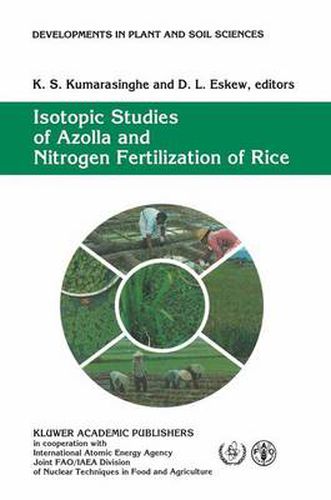Readings Newsletter
Become a Readings Member to make your shopping experience even easier.
Sign in or sign up for free!
You’re not far away from qualifying for FREE standard shipping within Australia
You’ve qualified for FREE standard shipping within Australia
The cart is loading…






This title is printed to order. This book may have been self-published. If so, we cannot guarantee the quality of the content. In the main most books will have gone through the editing process however some may not. We therefore suggest that you be aware of this before ordering this book. If in doubt check either the author or publisher’s details as we are unable to accept any returns unless they are faulty. Please contact us if you have any questions.
Nitrogen is the most limiting element for crop production. Traditionally, expensive commercial fertilizers are used to correct soil nitrogen deficiencies. Indeed, 50% of the increase in rice yields after World War II can be attributed to increased fertilizer nitrogen use. Although an increased rate of fertilizer nitrogen application has been advocated to meet the growing demand for food, it is unrealistic to advise the farmers to apply fertilizers they could hardly afford, and whose prices are likely to escalate in the years ahead. In addition, when they are not applied judiciously there are problems of environmental pollution as plants are capable of taking up only a relatively small portion of the applied nitrogen, a substantial amount being lost through various chemical and biological processes. The exploitation of cheaper alternatives or supplements to fertilizers have therefore gained much interest in recent years. Our increased interest in biological nitrogen fixation as a supplement or alternative to nitrogen fertilizers led to the convening of a consultants’ meeting on The Role of Isotopes in Studies on Nitrogen Fixation and Nitrogen Cycling by Blue-Green Algae and the Azolla-Anabaena azollae Association , in Vienna from 11-15 October 1982. The consultants’ group recommended that the joint FAO/IAEA Divison of Nuclear Techniques in Food and Agriculture embark on a co-ordinated research programme in this field and that the initial emphasis should be placed on Azolla-Anabaena symbiosis. As a result, such a programme was initiated in 1984, which was concluded in 1989. The results and conclusions reported here are those that were generated during the five years of its operation.
$9.00 standard shipping within Australia
FREE standard shipping within Australia for orders over $100.00
Express & International shipping calculated at checkout
This title is printed to order. This book may have been self-published. If so, we cannot guarantee the quality of the content. In the main most books will have gone through the editing process however some may not. We therefore suggest that you be aware of this before ordering this book. If in doubt check either the author or publisher’s details as we are unable to accept any returns unless they are faulty. Please contact us if you have any questions.
Nitrogen is the most limiting element for crop production. Traditionally, expensive commercial fertilizers are used to correct soil nitrogen deficiencies. Indeed, 50% of the increase in rice yields after World War II can be attributed to increased fertilizer nitrogen use. Although an increased rate of fertilizer nitrogen application has been advocated to meet the growing demand for food, it is unrealistic to advise the farmers to apply fertilizers they could hardly afford, and whose prices are likely to escalate in the years ahead. In addition, when they are not applied judiciously there are problems of environmental pollution as plants are capable of taking up only a relatively small portion of the applied nitrogen, a substantial amount being lost through various chemical and biological processes. The exploitation of cheaper alternatives or supplements to fertilizers have therefore gained much interest in recent years. Our increased interest in biological nitrogen fixation as a supplement or alternative to nitrogen fertilizers led to the convening of a consultants’ meeting on The Role of Isotopes in Studies on Nitrogen Fixation and Nitrogen Cycling by Blue-Green Algae and the Azolla-Anabaena azollae Association , in Vienna from 11-15 October 1982. The consultants’ group recommended that the joint FAO/IAEA Divison of Nuclear Techniques in Food and Agriculture embark on a co-ordinated research programme in this field and that the initial emphasis should be placed on Azolla-Anabaena symbiosis. As a result, such a programme was initiated in 1984, which was concluded in 1989. The results and conclusions reported here are those that were generated during the five years of its operation.